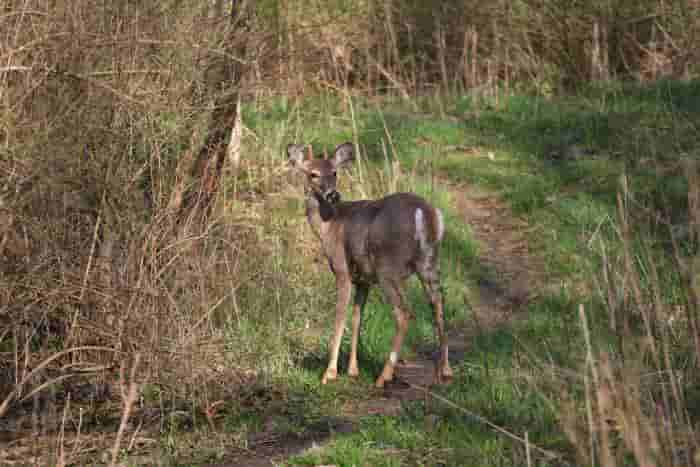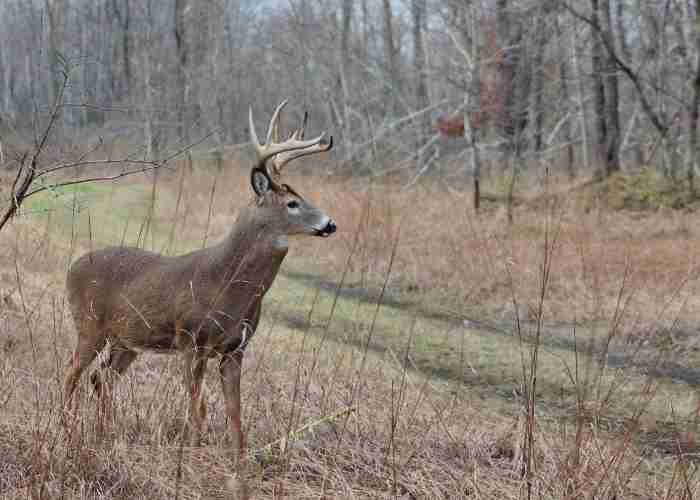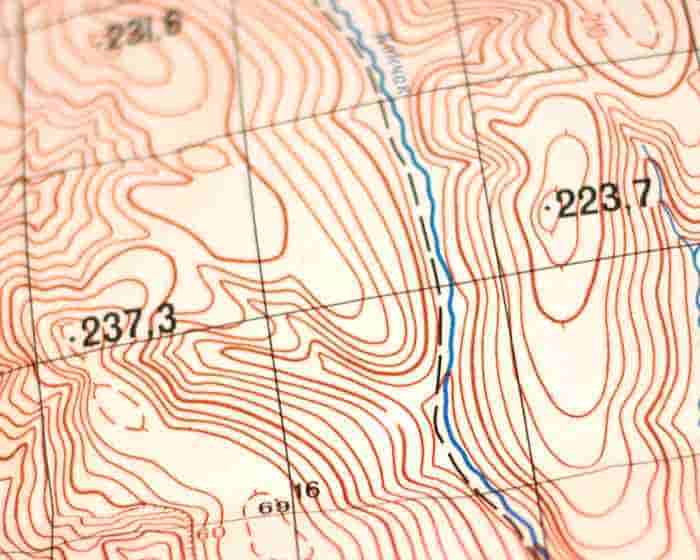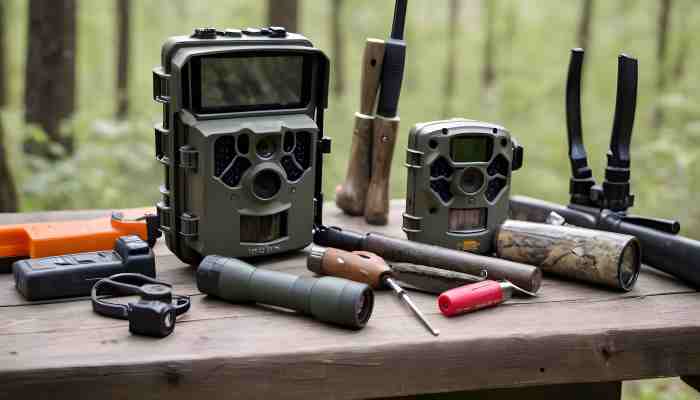Last updated on March 14th, 2024 at 11:29 am
Top Strategic Spots to Put Trail Cameras for Big Bucks – Unveiling the Secrets
Finding the ultimate spots for trail cameras is like unlocking a hidden treasure map that leads to the majestic big bucks you’ve been dreaming of. The thrill of the hunt begins long before the legal shooting hours; it starts with the strategic placement of your cameras. Its necessary to understand the natural habits and movements of deer, especially as the season progresses, so that you can position your cameras in locations where big bucks are most likely to roam.
Key to this strategy is not just knowing where to place the cameras but “when“. As deer transition from summer food sources to more secure bedding areas, your cam placement should adapt. Pinch points, food plots, and water sources become goldmines for capturing the majestic strides of a trophy buck. It’s about being in the right place at the right time, with your camera ready to catch that perfect moment.
Trail Camera Placement
Strategic cam placement is more than just setting up a camera and hoping for the best.
It’s about meticulously analyzing deer behavior, seasonal changes, and the landscape to choose the most effective locations.
The right placement can turn a season of waiting into a season of action, giving you insights and opportunities at big bucks that you might otherwise miss.
Understanding the fundamental principles of where and how to place your cameras can drastically change the game.
The Importance of Strategic Placement for Big Bucks
Positioning your trail cameras strategically is crucial for targeting big bucks.
These elusive creatures require a careful approach, and by placing your cameras in their preferred natural habitats, you are likely to increase your chances of capturing them on film.
It’s about making informed decisions based on deer behavior and the landscape, turning your hunting area into a well-monitored zone where big bucks feel safe yet are consistently observed.
Understanding Deer Behavior and Movement Patterns
Deer, especially big bucks, are creatures of habit. They follow specific movement patterns that change with the seasons, food availability, and breeding cycles.
Understanding these patterns is essential for effective camera placement. By tracking where deer feed, bed, and travel, you can predict their next moves.
This knowledge allows you to set up your cameras in spots where deer are most likely to pass, increasing your chances of capturing valuable footage.

Key Locations for Trail Cameras
Choosing the right trail cam locations is paramount for success.
Whether it’s near food sources, water sources, or along travel corridors, each location offers unique insights into deer behavior.
Diversifying your camera placement across these key areas will help you create a comprehensive surveillance network that covers the most critical aspects of a deer’s daily routine.
This strategic approach ensures you don’t miss out on any opportunities to observe and learn from the deer on your property.
1. The Vital Role of Water Sources
Water sources are magnets for wildlife, especially during dry seasons. Food plots nearby can enhance these spots, making them irresistible to deer.
When scouting efforts reveal travel corridors leading to these watering holes, it’s a sign that both young bucks and mature deer frequent the area.
Mature bucks tend to be more nocturnal and wary of open areas during daylight. However, when coming to drink water, they often let their guard down a bit, allowing you to more easily capture daytime images.
Pay attention to patterns of when bucks visit water sources. As the rut approaches, mature bucks will shift more of their movements to daylight hours, and you can capture them checking for does at watering holes.
Placing your cameras here, you’ll not only capture drinking and social behavior but also have a chance to observe bedded deer seeking refuge in the daytime bedding areas nearby.
Multiple trails converging on a water source are often lined with deer tracks, signaling a high-traffic spot.
Identifying Prime Watering Holes During Dry Seasons
For a whitetail hunter, finding the perfect watering hole during the dry season can be like striking gold. These prime spots become gathering places for deer, offering a rare opportunity to observe and capture a wide range of behaviors.
Look for springs or seeps coming out of hillsides. The water flow here remains fairly consistent regardless of weather. Set up a camera where the game trail leads down to the water.
Scout out ponds or small lakes, especially those fed by springs or streams. The water level may drop during droughts but often doesn’t disappear completely.
Check out creek crossings or bends. Even if much of the creek dries up, there are usually still pools or trickles of water at crossings or sharp turns that deer will visit to drink. Concentrate cameras at these spots.
By placing your cameras strategically around these areas, you can catch the intimate moments of deer life – from the cautious approach of a mature buck to the playful antics of fawns. These watering holes are not just about quenching thirst; they’re a vital part of the ecosystem you’re monitoring.
2. Bedding Areas – A Sanctuary for Big Bucks
Bedding areas are where big bucks find sanctuary and rest. These secluded spots are critical for their survival, making them a top priority for your camera placement.
However, it’s essential to approach these areas with caution to avoid disturbing the natural behavior of the deer.
Get an understanding of the layout of the land, including field edges and travel routes, so that you can position your cameras to monitor these areas without intrusion.

The Art of Positioning Cameras Without Disturbance
Positioning cameras near bedding areas requires a delicate balance.
Identify bedding areas first. Look for thick brush, evergreens, or tall grass areas that provide cover and thermal protection. Tracks, droppings, trails, and buck rubs can also help locate bedding zones.
Focus on main trails leading in and out of the bedding area. Big bucks will use these main runways as they enter and exit the bedding zone. Capture images as they transition.
Set up trail cameras 100-200 yards away from the bedding areas. You don’t want to alarm deer with your intrusion into the core bedding zone.
This approach allows you to observe without altering the behavior of your quarry, maintaining the integrity of your hunt.
3. Food Sources and Corn Piles
Food sources, such as corn piles and alfalfa fields, are highly defined areas that attract deer consistently.
These spots offer a reliable way to observe deer behavior, dietary preferences, and social interactions.
Placing your trail cameras in these areas will help you to gather information on the types and sizes of deer frequenting the area, to tailor your hunting strategies accordingly.
Maximizing Opportunities at Prime Feeding Grounds
Positioning your cameras at prime feeding grounds allows you to witness frequent visits from deer.
For planted food plots, set up cameras on the primary trails leading into and out of the plots. Capture images of bucks as they transition from cover to feed.
For agricultural crops like soybeans and corn fields, target the standing crops along the field edges that border woods and thickets. These funnels are excellent ambush sites for mature bucks.
Clear away any obstructing vegetation in front of the cameras to prevent false triggers or blocked subjects.
This constant activity provides a wealth of footage, enabling you to study the habits and preferences of the local deer population.
Use multiple cameras to monitor different parts of the food source from various angles and approaches. More coverage means better chances of capturing big bucks.
By attracting deer to these spots, you not only get a closer look at your potential targets but also learn the best times for observation and hunting.
4. Mineral Sites – Attractants Throughout the Year
Mineral sites serve as a year-round attractant for deer, making them essential for land managers looking to monitor and manage their deer populations.
These sites offer a unique opportunity to observe deer in a natural setting, providing insights into their nutritional needs and social hierarchies.
Placing your cameras near these sites can yield valuable information throughout the different seasons, helping you to understand the changing dynamics of your local deer population.
Timing Your Surveillance for Peak Activity
Monitoring mineral sites requires timing your surveillance to coincide with peak activity periods.
By understanding when deer are most likely to visit these sites, you can adjust your camera settings to capture the most action.
This strategic approach ensures that you don’t miss any crucial moments, providing a comprehensive overview of deer behavior and preferences at these key locations.

5. Travel Corridors and Pinch Points
Travel corridors and pinch points are critical for understanding the movement patterns of whitetail deer.
These natural pathways between food sources and bedding areas offer a glimpse into the daily life of deer, allowing you to predict their movements with greater accuracy.
By placing your cameras in these strategic locations, you can capture a wide range of behaviors, from solitary bucks on the move to groups of does and fawns navigating the landscape.
Capturing Movement Between Feeding and Bedding Areas
Using scouting cameras along travel corridors and pinch points is an effective way to capture the movement between feeding and bedding areas.
This placement gives you a front-row seat to the routines of the local deer population, providing valuable insights into their travel patterns and preferred routes.
With this information, you can fine-tune your hunting strategies, increasing your chances of a successful encounter with a big buck.
6. The Edge of Fields and Food Plots
Edge habitats, where the woods meet a field or food plot, are treasure troves for whitetail hunters. These areas are frequented by deer herds, especially big bucks, due to the abundant food sources and cover.
By placing your trail camera on well-used trails along these field edges, you’re more likely to capture images of these elusive animals. Moreover, these locations offer unique opportunities for habitat improvement, enhancing the overall hunting strategy as the hunting season approaches.
Evening Encounters: The Best Time for Camera Checks
Evening times are pivotal at the field edges, where deer, including big bucks, are more likely to emerge from their hiding spots.
Understanding the travel routes and by identifying pinch points near these edges, you can position your cameras to capture the most activity.
This knowledge will help you avoid frequent disturbances in these areas, making evening the best time to discreetly check your cameras, ensuring the deer continue to use these travel routes undisturbed.
Advanced Tips and Techniques
Utilizing advanced strategies can transform your trail camera usage from simple monitoring to a sophisticated scouting tool. By incorporating terrain features, understanding deer movement, and adjusting your approach seasonally, you can significantly increase your chances of success. These advanced techniques require patience and persistence but can lead to more effective and rewarding hunting experiences.
Utilizing Terrain Features to Your Advantage
Deer are creatures of habit, often using the same travel corridors and seeking out food sources in predictable patterns.
Identify terrain funnels – Places where two different types of terrain meet, creating a narrow passage deer tend to use. Examples are where thick woods meets an open field, or where flat land meets steep hills. Set up cameras here.
Saddle areas – Low points along a ridgeline are prime travel corridors. Bucks will utilize these to move from one area to another without having to go up and over the higher points. Great for cameras.
Transitional zones – Where two habitat types meet, such as cropland/woods borders or where woods meets grasslands. Bucks like to hang out and patrol these edges. Capture them on camera there.
Inside corners – An inside corner is where two land features almost meet, like two hedgerows or woods lines. Deer funnel through these corners, allowing camera placement to intercept them.
By understanding these behaviors and utilizing terrain features like mature hardwoods and south facing slopes for daytime bedding, you can place your cameras to capture these movements.
Mapping Out Hotspots with Topographical Maps

Topographical maps (also called topo maps) are detailed maps that show the shape and elevation of the land using contour lines.
These maps are invaluable tools for identifying potential hotspots without stepping foot in the area.
They reveal key terrain features such as mature hardwoods, south facing slopes for daytime bedding, and areas surrounding food sources.
Contour lines show changes in elevation. Closely spaced lines indicate very steep terrain. Widely spaced lines indicate gentle terrain
Bucks prefer to move through funnels and saddles – where steep meets gentle terrain. These funnels show up clearly on topo maps as tight contour lines transitioning to wide open lines. Prime real estate for catching big bucks on camera.
You can identify terrain features like ridges, valleys, saddles, inside corners, etc on topo maps. Bucks use these features to move safely and efficiently.
By analyzing these maps, you can pinpoint where mature bucks are likely to travel, feed, and rest, allowing for strategic trail camera placement to monitor these patterns throughout the seasons.
Seasonal Adjustments for Trail Camera Placement
As the season rolls from the lushness of summer to the sparse vegetation of fall, deer movement patterns shift.
Recognizing these changes is crucial for adjusting your trail camera strategy to maintain surveillance on the local deer herd.
This seasonal adjustment ensures that you continue to gather useful data on deer behavior, helping to refine your hunting strategy for the upcoming season.
Also Read > Deer Hunt 101: Early Season Trail Camera Placement Strategies
Transitioning from Summer to Fall – What Changes?
During the transition from summer to fall, deer shift their patterns in response to changing food sources and the need for mating.
This period requires adjustments to trail camera placement, focusing more on travel corridors between bedding and feeding areas, and less on summer feeding grounds.
Understanding these shifts allows you to anticipate where deer, especially mature bucks, will be, making your hunting preparations more effective.
Gear Recommendations
Selecting the right gear is essential for any successful whitetail strategy.
From trail cameras to habitat management tools, the choices you make can significantly impact your ability to monitor and attract big bucks.
Investing in quality gear tailored to your specific needs and the characteristics of your hunting grounds can enhance your chances of success.
Essential Tools for Maximizing Your Trail Camera Use
To get the most out of your trail cameras, incorporating a mix of essential tools is crucial.
This includes high-capacity memory cards for long-term monitoring, solar chargers to extend field life, and security boxes to protect your investment.
These tools ensure your cameras remain operational and secure throughout the season, providing continuous data on deer movement and behavior.

Don’t Overlook the Basics: Conventional vs. Cellular Trail Cameras
When choosing between conventional and cellular trail cameras, it’s essential to consider your specific needs and hunting grounds.
North American Whitetail’s Blake Garlock emphasizes that while conventional cameras are reliable and cost-effective, cellular cameras offer real-time monitoring and data transmission, allowing for immediate adjustments to your hunting strategy.
The Pros and Cons of Each Type for Monitoring Big Bucks
Conventional trail cameras are valued for their reliability and simplicity, perfect for areas with easy physical access.
On the other hand, cellular cameras provide instant updates and images, making them ideal for remote areas or for hunters who cannot frequently check their cameras.
However, cellular models come with higher initial costs and require a data plan, considerations that can influence your decision based on budget and specific needs.
Digital Resources for Hunters
In today’s digital age, hunters have access to a vast array of online resources to enhance their hunting experiences.
From digital magazines and forums to mobile apps that track game and weather, these resources provide invaluable information and tools for planning successful hunts.
Staying updated with the latest innovations and strategies through these digital platforms can give hunters an edge in the field.
Buy Digital Single Issues
Purchasing digital single issues of hunting magazines offers a flexible and convenient way to stay informed about the latest trends, gear, and techniques in the hunting world.
These digital issues provide instant access to a wealth of knowledge, allowing hunters to quickly adapt to new information and incorporate it into their strategies.
Keeping Updated with the Latest in Trail Camera Innovations
With technology constantly evolving, keeping up with the latest trail camera innovations is crucial for hunters aiming to monitor big bucks effectively.
Cellular cameras, for instance, represent a significant advancement, offering the ability to receive real-time images directly to your smartphone.
This capability allows for immediate adjustments to strategies, giving hunters a significant advantage in tracking and understanding deer behavior.
Leveraging Trail Camera Data
When you start to dive into the data your trail cameras collect, you unlock a treasure trove of insights about deer movement.
By systematically analyzing trail camera photos, you can begin to understand the daily and seasonal patterns of big bucks.
This process isn’t just about seeing a deer; it’s about compiling evidence to predict where and when these bucks will move, turning raw data into a strategic hunting advantage.
Analyzing Images for Behavioral Insights
Every photo captured by your trail camera is a piece of the puzzle. By paying close attention to the time stamps and the context of each trail camera photo, you can start to piece together a buck’s routine.
You’ll notice patterns, such as the time of day they prefer to feed and the trails they frequent, which can significantly inform your hunting strategies.
Pattern Recognition: The Key to Predicting Big Buck Movement
Recognizing patterns in buck movement becomes your strategic edge.
For instance, if you consistently see a particular buck visiting a food source at dawn, you can plan your hunting around this behavior.
Understanding these patterns takes time and patience but is crucial for anticipating where a buck will be, especially during the hunting season.
Case Studies and Success Stories
Reflecting on the successes of fellow whitetail hunters can inspire and inform your approach.
Many have shared their journey from initial scouting efforts, through the meticulous analysis of trail cam photos, to the thrilling moment of a successful harvest.
These stories underline the importance of persistence, showing that understanding deer movement and behavior through trail camera data can lead to remarkable hunting achievements.
From Scouting to Harvest: A Hunter’s Journey
One common thread in these stories is the role of trail cameras in transforming scouting efforts into successful hunts.
Hunters recount how trail cam photos provided the first evidence of a monster buck in their area.
Over weeks and months, by carefully avoiding human scent and allowing deer to become accustomed to the cameras, they were able to predict and plan for the moment of harvest, turning patience and data into success.
Conclusion: The Hunter’s Edge
Mastering trail camera strategies and interpreting the data they provide are crucial steps in refining your hunting approach. From summer scouting to adjusting your strategy based on the latest trail camera photo, every piece of information helps sharpen your edge. It’s a game of patience, observation, and adaptation, where each data point can lead to a successful hunt.
How Strategic Trail Camera Placement Leads to Successful Hunts
Choosing the right spots for your cameras can make all the difference.
Placing your cameras near favorite trails, doe bedding areas, and sources of food and cover, while mindful of wind directions, can reveal patterns in buck movement.
This strategic placement, especially in the weeks leading up to bow season, is often what separates successful deer hunters from those who return empty-handed.
Embracing Patience and Persistence: The Ultimate Strategy
Patience and persistence are your best allies in hunting. The data from your trail cameras, including the specific times and places of deer activity, are invaluable.
But it’s your willingness to wait, to learn, and to adapt based on what the cameras tell you that ultimately brings success. Remember, every target buck has a pattern; it’s up to you to decipher it and plan your hunt around it, ensuring ethical and rewarding pursuits.


